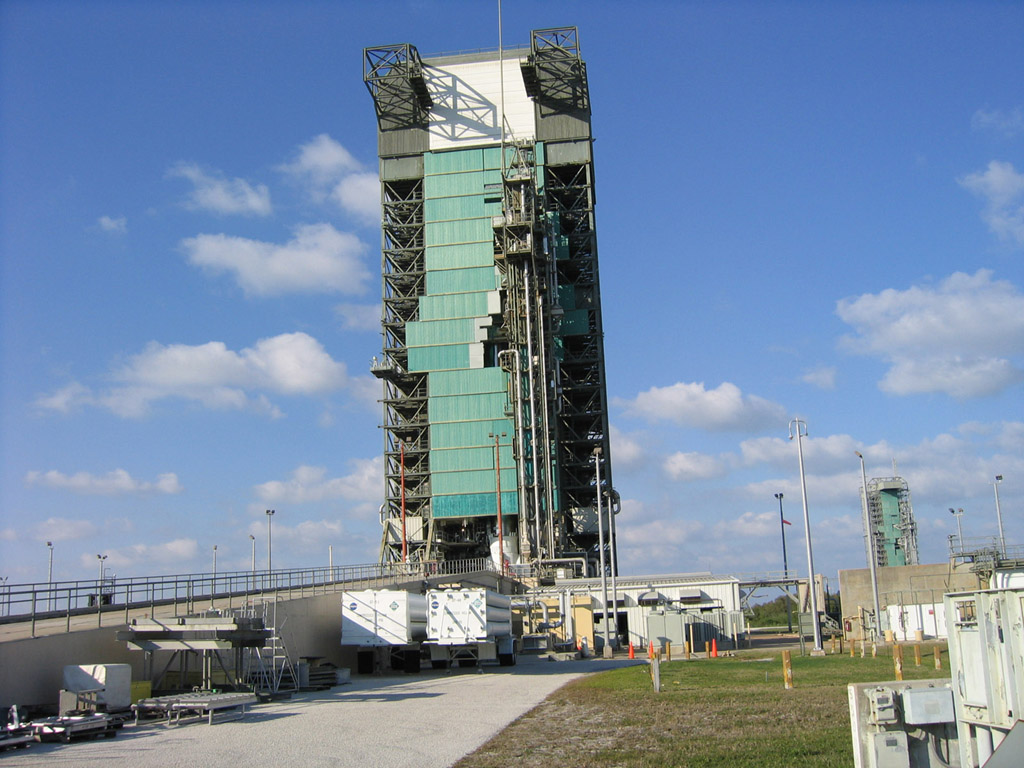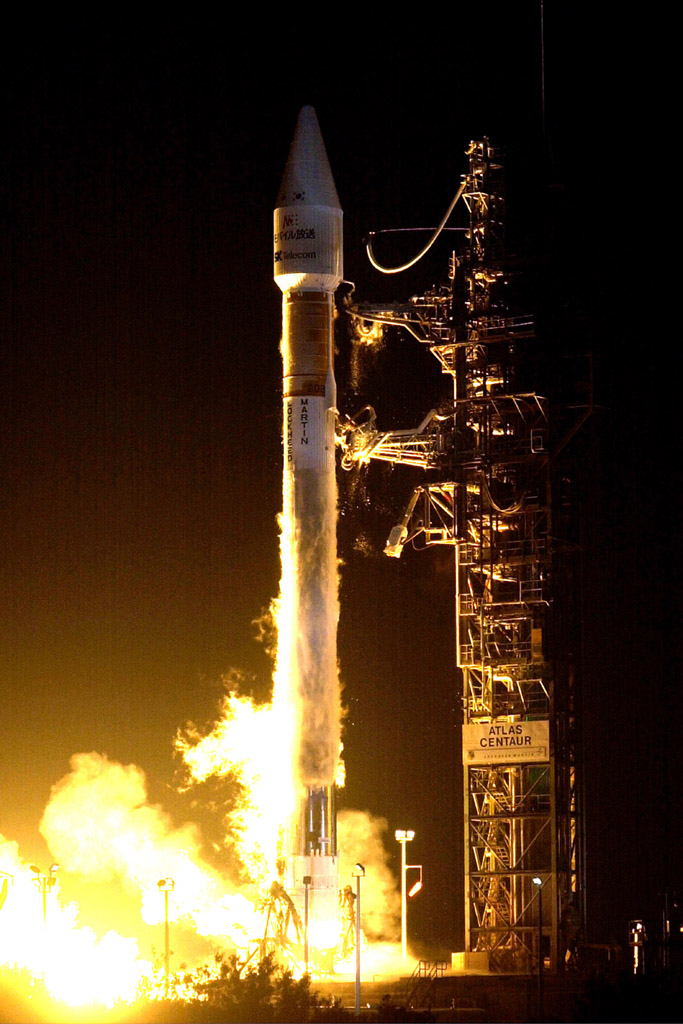content area
Press Release
SK Telecom Successfully Launches a DMB Satellite for the First Time in the World.
2004.03.13The preparations for launching a satellite DMB service were completed by the successful launch of its satellite. This occurred following the amendment of Korean broadcasting laws.
SK Telecom plans to begin a pilot satellite DMB service in May, after acquiring a service business license. Then in July of this year, the first commercial service in the world will begin.
The world’s first satellite for mobile multimedia broadcasting service (Korean Name: "Araeahanbyul", Japanese Name: "MBSat") was successfully launched at 00:40 (14:40 Korean time) on March 13.
The "Araeahanbyul" is now orbiting at an altitude of 35,785.6 km from the ground after being carried aloft on the rocket "Atlas IIIA" at 14:40 sharp Korean time, on March 13th.
The satellite successfully went into orbit at 15:08, 28 minutes and 39 seconds after blast-off. The location of the satellite was clearly identified by the frequency transmitted from the satellite at 15:23, 43 minutes after blast-off.
The satellite blast-off ceremony took place at the Kennedy Space Center in Florida, U.S.A. Over 100 Korean and Japanese businesspersons participated in the ceremony, and then watched the successful launch of the satellite. They include Young Gil Seo, vice-president and head of SK Telecom’s Customer Relations Center, Jun Dong Bae, vice-president of TU Media Corp., and Mijoguchi Techeuya, president of the Mobile Broadcasting Corporation (MBCo), a satellite DMB service provider in Japan.
This satellite is designed to provide satellite DMB service in both Korea and Japan. In this regard, the two countries agreed to strengthen the cooperative ties in the business, and compete in good faith as they usher in the world’s first mobile broadcasting era.
The satellite blast-off project largely consisted of eight stages: Booster rocket engine running (lasting 3 minutes and 1.3 seconds), Central rocket separation (lasting 3 minutes and 7.4 seconds), Main engine ignition (lasting 3 minutes and 18.3 seconds), Satellite protection fairing separation (lasting 3 minutes and 26.3 seconds), Preparatory orbit space-walk by the separation of main engine (lasting 12 minutes and 35.8 seconds), Preparatory orbit secession after engine re-ignition (lasting 22 minutes and 54.8 seconds), Separation between satellite and rocket (lasting 28 minutes and 39.4 seconds), Safe arrival in the geostationary orbit (lasting 12 days).
In addition, the satellite launch project will be completed by taking the following four steps:
* Going into the 1st stage Parking Orbit located at an altitude of 939.9km from the ground
* Entering into the 2nd stage Transfer Orbit at an altitude of 35,944.2km after the satellite separation
* Going into the 3rd stage Transfer Orbit at an altitude of 35,785.6km which is the same altitude as that of the Geostationary Orbit
* Entering into the Geostationary Orbit through motor force
The "Araeahanbyul" will have safely arrived at the Geostationary Orbit located at an altitude of about 36,000km by the 25th of March, 12 days after its blast-off. The satellite will go round the earth at a speed of 11,000km per hour, which is the same speed as that of earth rotation. Thus, it will look like it is at a standstill when viewed from the earth.
ILS, a satellite blast-off company in the U.S., will take charge of satellite management for the 28 minute period from the satellite launch to the satellite body separation. After a one month In-Orbit-Test carried out by SS Loral, the satellite management rights will be transferred to Korea’s SK Telecom and Japan’s MBCo, which are the owners of the satellite.
SS Loral will dispatch engineers who have specialized in satellites to both companies, and these engineers will assist them in operating the satellite for six months. This will contribute to quickly solving any problems in the initial stages of satellite management, and hastening the development of in-house operational know-how.
Young Gil Seo, vice-president and head of SK Telecom’s Customer Relation Center, commented at a press interview just before the launch of the satellite, "With the successful blast-off of the satellite, we will have completed our preparations for ushering in a whole new mobile multimedia broadcasting era in Korea. SK Telecom will certainly offer the very best in satellite broadcasting service to its customers, ensuring the success of the satellite DMB business".
The DMB satellite called "Araeahanbyul" has been under development at Space Systems Loral, located in Palo Alto Ca. in the U.S., starting in December 2001. It was completed on February 11, and moved to the Kennedy Space Center in Florida, and is ready for launch. This satellite was built in a joint effort between SK Telecom and Japan’s Mobile Broadcasting Corporation (MBCO). This was in accordance with a contract for joint possession of a satellite, signed by the two companies in September 2003.
The launch of this satellite is drawing keen attention from satellite operators and IT companies worldwide because it is the world’s first satellite for DMB. Its launch has great significance in securing a leadership role in the DMB market for both Korea and Japan.
Based on the coverage and the number of base stations each company will operate, SK Telecom and MBCO determined a satellite purchase ratio of 34.66%(SK Telecom), and 65.34%(MBCO) respectively. Therefore, SK Telecom will furnish about 94.5 billion Korean won, out of the total of 272.0 billion won required to cover the cost of satellite purchase, satellite launch, control tower operation, insurance, etc. Under this contract for joint operation of a satellite, SK Telecom will share satellite, insurance, ground control tower, and operational costs. This will result in a saving of about 200 billion won over the cost of operating a satellite on its own.
Jun Dong Bae, head of TU Media Corp., which is in charge of the satellite DMB business in Korea stated, "Developing terminals, and securing the satellite and a frequency for the satellite DMB business, is proceeding without a setback. With the successful launch of the satellite, preparations for the service are completed. In the future, we will be fully ready to become a satellite DMB service provider".
Satellite DMB is a new service that will allow subscribers to access all multimedia broadcast channels at any time and anywhere, via special receivers in mobile handsets and automobiles.
The "Araeahanbyul" is now orbiting at an altitude of 35,785.6 km from the ground after being carried aloft on the rocket "Atlas IIIA" at 14:40 sharp Korean time, on March 13th.
The satellite successfully went into orbit at 15:08, 28 minutes and 39 seconds after blast-off. The location of the satellite was clearly identified by the frequency transmitted from the satellite at 15:23, 43 minutes after blast-off.
The satellite blast-off ceremony took place at the Kennedy Space Center in Florida, U.S.A. Over 100 Korean and Japanese businesspersons participated in the ceremony, and then watched the successful launch of the satellite. They include Young Gil Seo, vice-president and head of SK Telecom’s Customer Relations Center, Jun Dong Bae, vice-president of TU Media Corp., and Mijoguchi Techeuya, president of the Mobile Broadcasting Corporation (MBCo), a satellite DMB service provider in Japan.
This satellite is designed to provide satellite DMB service in both Korea and Japan. In this regard, the two countries agreed to strengthen the cooperative ties in the business, and compete in good faith as they usher in the world’s first mobile broadcasting era.
The satellite blast-off project largely consisted of eight stages: Booster rocket engine running (lasting 3 minutes and 1.3 seconds), Central rocket separation (lasting 3 minutes and 7.4 seconds), Main engine ignition (lasting 3 minutes and 18.3 seconds), Satellite protection fairing separation (lasting 3 minutes and 26.3 seconds), Preparatory orbit space-walk by the separation of main engine (lasting 12 minutes and 35.8 seconds), Preparatory orbit secession after engine re-ignition (lasting 22 minutes and 54.8 seconds), Separation between satellite and rocket (lasting 28 minutes and 39.4 seconds), Safe arrival in the geostationary orbit (lasting 12 days).
In addition, the satellite launch project will be completed by taking the following four steps:
* Going into the 1st stage Parking Orbit located at an altitude of 939.9km from the ground
* Entering into the 2nd stage Transfer Orbit at an altitude of 35,944.2km after the satellite separation
* Going into the 3rd stage Transfer Orbit at an altitude of 35,785.6km which is the same altitude as that of the Geostationary Orbit
* Entering into the Geostationary Orbit through motor force
The "Araeahanbyul" will have safely arrived at the Geostationary Orbit located at an altitude of about 36,000km by the 25th of March, 12 days after its blast-off. The satellite will go round the earth at a speed of 11,000km per hour, which is the same speed as that of earth rotation. Thus, it will look like it is at a standstill when viewed from the earth.
ILS, a satellite blast-off company in the U.S., will take charge of satellite management for the 28 minute period from the satellite launch to the satellite body separation. After a one month In-Orbit-Test carried out by SS Loral, the satellite management rights will be transferred to Korea’s SK Telecom and Japan’s MBCo, which are the owners of the satellite.
SS Loral will dispatch engineers who have specialized in satellites to both companies, and these engineers will assist them in operating the satellite for six months. This will contribute to quickly solving any problems in the initial stages of satellite management, and hastening the development of in-house operational know-how.
Young Gil Seo, vice-president and head of SK Telecom’s Customer Relation Center, commented at a press interview just before the launch of the satellite, "With the successful blast-off of the satellite, we will have completed our preparations for ushering in a whole new mobile multimedia broadcasting era in Korea. SK Telecom will certainly offer the very best in satellite broadcasting service to its customers, ensuring the success of the satellite DMB business".
The DMB satellite called "Araeahanbyul" has been under development at Space Systems Loral, located in Palo Alto Ca. in the U.S., starting in December 2001. It was completed on February 11, and moved to the Kennedy Space Center in Florida, and is ready for launch. This satellite was built in a joint effort between SK Telecom and Japan’s Mobile Broadcasting Corporation (MBCO). This was in accordance with a contract for joint possession of a satellite, signed by the two companies in September 2003.
The launch of this satellite is drawing keen attention from satellite operators and IT companies worldwide because it is the world’s first satellite for DMB. Its launch has great significance in securing a leadership role in the DMB market for both Korea and Japan.
Based on the coverage and the number of base stations each company will operate, SK Telecom and MBCO determined a satellite purchase ratio of 34.66%(SK Telecom), and 65.34%(MBCO) respectively. Therefore, SK Telecom will furnish about 94.5 billion Korean won, out of the total of 272.0 billion won required to cover the cost of satellite purchase, satellite launch, control tower operation, insurance, etc. Under this contract for joint operation of a satellite, SK Telecom will share satellite, insurance, ground control tower, and operational costs. This will result in a saving of about 200 billion won over the cost of operating a satellite on its own.
Jun Dong Bae, head of TU Media Corp., which is in charge of the satellite DMB business in Korea stated, "Developing terminals, and securing the satellite and a frequency for the satellite DMB business, is proceeding without a setback. With the successful launch of the satellite, preparations for the service are completed. In the future, we will be fully ready to become a satellite DMB service provider".
Satellite DMB is a new service that will allow subscribers to access all multimedia broadcast channels at any time and anywhere, via special receivers in mobile handsets and automobiles.



